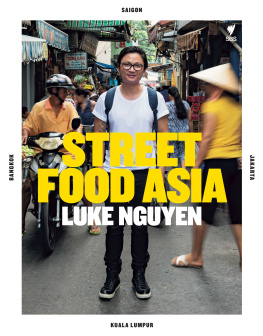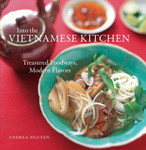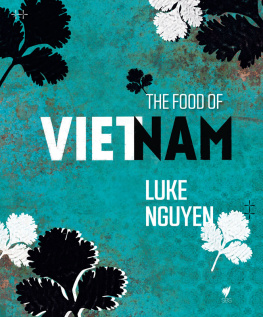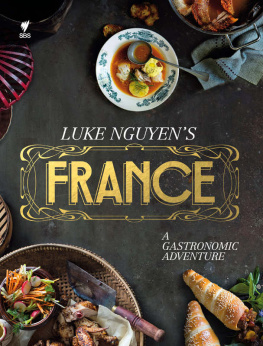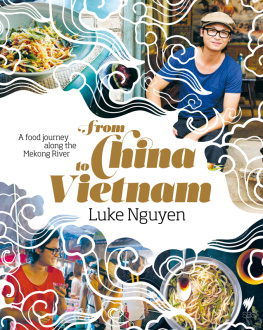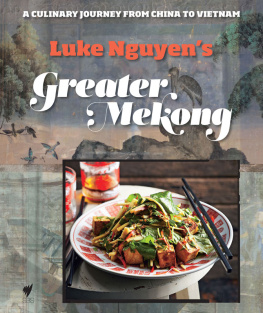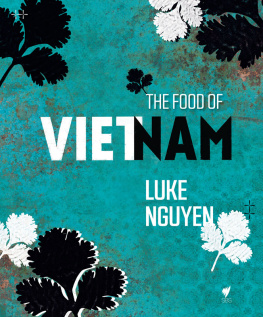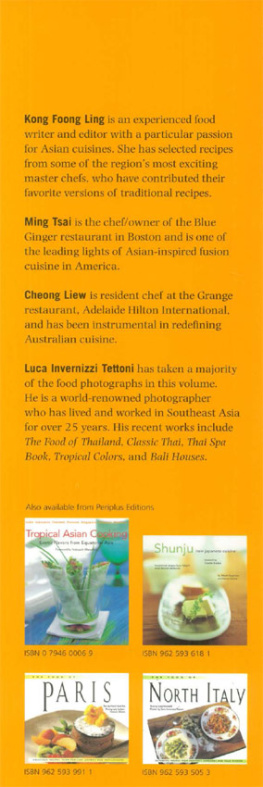Nguyen - Street Food Asia
Here you can read online Nguyen - Street Food Asia full text of the book (entire story) in english for free. Download pdf and epub, get meaning, cover and reviews about this ebook. City: East Asia, year: 2016, publisher: Hardie Grant, genre: Home and family. Description of the work, (preface) as well as reviews are available. Best literature library LitArk.com created for fans of good reading and offers a wide selection of genres:
Romance novel
Science fiction
Adventure
Detective
Science
History
Home and family
Prose
Art
Politics
Computer
Non-fiction
Religion
Business
Children
Humor
Choose a favorite category and find really read worthwhile books. Enjoy immersion in the world of imagination, feel the emotions of the characters or learn something new for yourself, make an fascinating discovery.
- Book:Street Food Asia
- Author:
- Publisher:Hardie Grant
- Genre:
- Year:2016
- City:East Asia
- Rating:4 / 5
- Favourites:Add to favourites
- Your mark:
- 80
- 1
- 2
- 3
- 4
- 5
Street Food Asia: summary, description and annotation
We offer to read an annotation, description, summary or preface (depends on what the author of the book "Street Food Asia" wrote himself). If you haven't found the necessary information about the book — write in the comments, we will try to find it.
Street Food Asia — read online for free the complete book (whole text) full work
Below is the text of the book, divided by pages. System saving the place of the last page read, allows you to conveniently read the book "Street Food Asia" online for free, without having to search again every time where you left off. Put a bookmark, and you can go to the page where you finished reading at any time.
Font size:
Interval:
Bookmark:



W hether eating fiery som tum on a bustling Bangkok street, slurping ph in Vietnam perched on a red plastic stool, inhaling the galangal, lemongrass and coconut-infused air of Jakarta, or being seduced by heady wafts of succulent satay as it grills in Kuala Lumpur, theres nothing more alluring than street food. I love, love, love it, in all its permutations. When I travel, my top priority is hitting the pavement in search of interesting things to eat, making sure I do this at a slow pace and with my ears, eyes and nose on constant red alert. Down alleys and around every bend in the road, theres a tucked-away kitchen or mobile cart dispensing hot, smoky, freshly cooked deliciousness and I dont want to miss a single edible thing.
Discovering local street food is the best way I know to understand a place and instantly feel connected to it. Its my ultimate buzz and the fact that it comes complete with flames, steam, smoke, smells, sounds, colour, heat, energy, good vibes and a ton of flavour, only makes it better. Now I want to take you with me on an adventure to some of my favourite Asian nooks and crannies places where fantastic street food still reigns supreme.
All over South-East Asia, the street food repertoire is vast. Getting to know every dish and its regional spin-offs would take a lifetime and thats part of the allure theres so much to know and Im constantly making new discoveries. The adventure isnt just about uncovering the technicalities of a particular dish though as there are also, invariably, fascinating backstories and compelling snippets of family and food history involved. And then there are the dedicated cooks. I love watching street cooks work; I love hearing their stories, I love seeing the skill, care and passion they put into every dish they make. Cooks tend to be generous people and nowhere more so than on the street I gain so much in knowledge and in my humanity every time I get out among authentic street food action.
According to the Food and Agriculture Organization of the United Nations, 2.5 billion people globally eat street food every day. Street food evolved around necessity; people had tiny living spaces so home kitchens werent an option and, in some countries, this still holds true for many. Mobile food hawking is a way to get nutritious, affordable, varied, ready-cooked food to the urban masses while supporting local economies; food vendors tend to purchase from the nearest market, stocked with local produce, according to what is in season. Less tangible benefits of street food culture include the preservation of traditional cooking styles and the fostering of community. Yes, street cooking is evolving, particularly in more developed places. But most often, street food dishes are cooked according to strict tradition, often passed down through generations of family stall-owners.
Street food brings people together, as folk crowd onto their neighbourhood streets to share meals and conversation at their favourite stall. Some vendors operate in the same spot for decades, giving a sense of continuation that can span several generations. And while Asian cities modernise at a rampant pace, with glimmering malls replacing gritty old laneways and younger generations becoming wealthier and more sophisticated by the nanosecond, street eating isnt going anywhere yet. It continues to cut across age, gender, religion, economic status and every other demography youd care to mention. Its at the core of the very fabric of cities like Bangkok, Kuala Lumpur, Jakarta and Saigon, making visits to these place just one giant excuse to eat amazingly good food, outdoors.
In this book, I want to take you with me as I delve into the street food scenes that thrive across some of my all-time favourite Asian cities. Youll find full recipes, as well as stories about some of the amazing dishes I came across on my travels, and where you can find them when you visit. Even if you cant be there in person, you can still create the smells, sounds, energy and flavours at home, in your very own kitchen, by cooking these recipes. I hope also that when you read about the vendors and street food cooks that have become special to me, and from whom I have learned so much, youll be inspired to seek them out when you do find yourself in Bangkok or Jakarta, Kuala Lumpur or Saigon. Eating their food, in situ, is the best kind of culinary travel experience you could possibly have.


S aigon. Crazy-hectic and developing at an astounding pace, its got an energy and dynamism you can almost smell. I totally love it. Maybe Im biased though, as the city is now my second home. Its also where my family came from before they moved to Australia all those years ago, so the place is virtually in my DNA.
Naturally Im addicted to the street food, and I practically trip over it every day because this town is one heaving smorgasbord of outdoor dining options, wherever you venture or look. Seafood, fresh herbs, prodigious varieties of vegetables, sweetish, light flavours, and simple cooking styles are the hallmarks of Saigons food, though being Vietnams biggest city, theres plenty of regional fare from other corners of the country on offer too. Throw in some French influence (you havent lived until youve had Vietnamese drip coffee with condensed milk, or a crunchy-fluffy baguette filled with local charcuterie) and an uber-vibrant Chinatown and youve got an incredibly rich street food repertoire.
The locals all have their favourite food haunts and one of mine is C Giang Street in District 1. I like to come here early, when its still a little calm, and breakfast on bn tht nng, which consists of honey-marinated grilled pork, springy rice noodles, herbs, pickled vegetables, spring rolls and peanuts. This dish, typical of Saigon cuisine, contains every texture imaginable crunchy, slippery, chewy, snappy, slurpy.
During the day, as I poke around streets and back alleys across Saigons 24 districts, I cant stop grazing on tasty little snacks. Like bnh kht: crisp, soft-centred pancakes made in special pans using a turmeric-scented batter. You eat them with fresh herbs, wrapped in lettuce leaves and dipped in nuoc cham, or sweetened fish sauce. Then there are Saigons myriad soups, which are perfect for this hot climate. Sp cua c heo, or crab soup with pork brain, is light and fragrant and way more delicious than it might sound. Bn mm is a porky-seafoody noodle soup dish based on pungent, fermented anchovy stock thats really typical of this part of Vietnam, and another favourite dish. And, of course, theres ph. When people ask where I get the best ph (and they always do), I take them down an alleyway in District 1, through clouds of spice-infused steam, where the family at Ph Ngoc have been making this iconic dish for 40 years. Coming here is like being fed by your grandmother; the atmosphere is warm and the ph is indescribably good.
As night settles, the pace on the street intensifies, with scooters, cyclists and taxis zeroing in on favourite evening eats. I like to hang out in non-touristy District 4, where my uncle lives. The fragrance of lemongrass, lime, black pepper and garlic oil hangs in the air and theres cooking and eating activity right on the pavements. Uncle Four has shown me all his special haunts and now, if you come with me, Ill share them with you too.
Font size:
Interval:
Bookmark:
Similar books «Street Food Asia»
Look at similar books to Street Food Asia. We have selected literature similar in name and meaning in the hope of providing readers with more options to find new, interesting, not yet read works.
Discussion, reviews of the book Street Food Asia and just readers' own opinions. Leave your comments, write what you think about the work, its meaning or the main characters. Specify what exactly you liked and what you didn't like, and why you think so.

